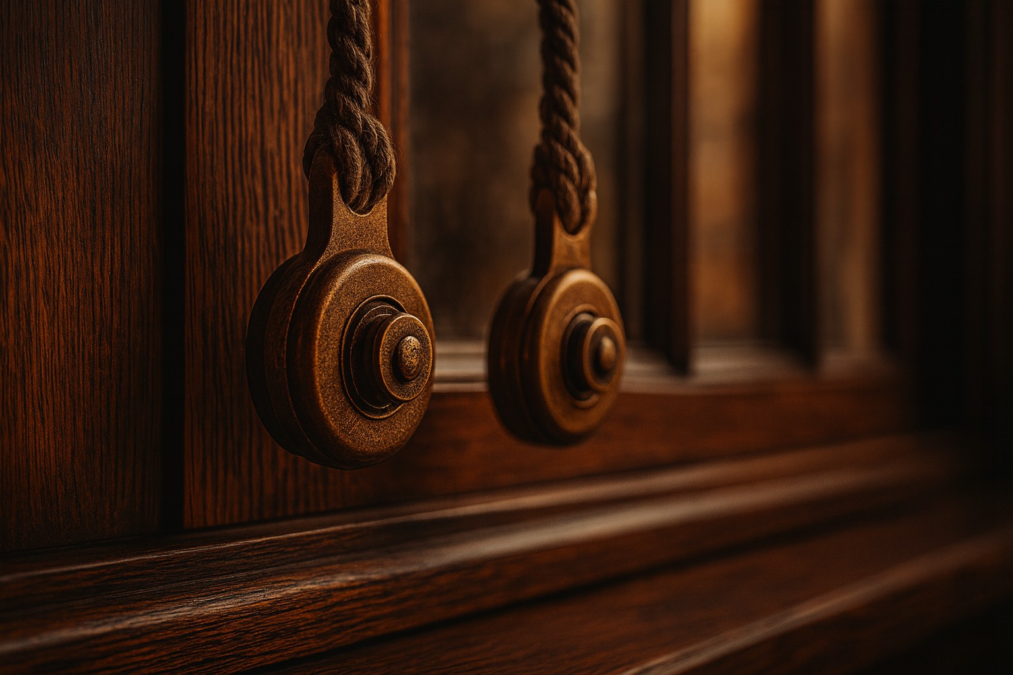Stop wrestling your sash windows. In the next few minutes you’ll see why they crash, stick and rattle, how hidden counterweights put everything right, and which quick, low-cost tweaks slash draughts and bills without touching your home’s character. Read on to keep the heat in, protect fingers, and make every sash glide like new.
Why counterweights matter in the first place
It’s a cold morning in Yorkshire. You grab your sash window to let in a bit of fresh air. Instead of sliding up smoothly, the top sash crashes down like a bag of potatoes, while the bottom sash stays stubbornly shut. That’s a clear sign your counterweights have given up.
Counterweights sit hidden behind the window panels, quietly doing all the heavy lifting. They raise and lower the glass, keep it steady where you want it, and stop icy draughts from sneaking into your living room. With energy bills climbing, well-balanced windows aren’t just nice to have — they keep your heat indoors and your home warm without wasting money.
How sash window counterweights actually work
Inside each sash box are weights attached to cords running over pulleys at the top. When you lift the sash, the weights travel down, balancing the load so your arms do not have to do all the work. If cords fray, pulleys seize, or weights go missing, the balance is ruined. That is when windows slam, rattle, or refuse to budge.
Traditionally, these weights were cast iron or lead, sometimes even steel. These days, there are modern recycled alternatives and adjustable modular weights that allow fine-tuning for heavier double-glazed sashes. The principle, though, has not changed since Georgian builders first fitted them.
Telltale signs of counterweight trouble include jerky movement, one sash falling closed with a theatrical bang, or cords looking as if a family of mice has been chewing them for sport. When any of these symptoms appear, it is time to give your windows some care before things worsen.
Why well-balanced windows make life better
Balanced counterweights do more than save your wrists. They keep your window frames under less stress, extend the life of cords and pulleys, and protect fingers from sudden slams if a sash decides to drop unexpectedly. Parents and pet owners will appreciate that point immediately.
You save energy when sashes close evenly and snugly. They block draughts, keep the heat in, and stop you cranking the thermostat. The period charm stays, and the room feels as warm as it looks.
A smooth-running sash is also quieter. Traffic noise and late-night chatter do not find as many sneaky routes indoors when sashes seal properly. For city dwellers, that is worth as much as the heating savings.
Options for repair, replacement, and upgrades
Not every window needs a full overhaul. Often, re-cording and rebalancing the existing weights is enough to restore smooth travel. If you have added slimline double glazing or acoustic glass, extra weight can be introduced to match the new sash mass without changing the original look.
Some later Victorian and Edwardian homes used external pulleys for easier access, while spiral balances appeared in the twentieth century as a modern alternative. Spiral systems avoid traditional weights entirely, using a spring mechanism instead. They can be a practical retrofit choice where cavity space is limited, though many heritage homeowners prefer the authenticity of original counterweights.
When you get to problems like rot, frayed cords, or seized pulleys, you’re past the point of a simple DIY fix. You need a professional. For a job like this in London, a team with a solid reputation for quality, like Scott James Sash Windows Specialists, is who you’d call. They handle everything from straightforward re-cording to the complex restorations that conservation officers approve. For listed properties, this keeps you on the right side of both building control and the neighbours peering over the hedge.
How the work is actually done
A typical repair begins with removing the inner staff bead so the sashes can be taken out carefully. Pocket covers on the box sides open to reveal the weights hiding within. Old cords come out, pulleys get checked and cleaned, and sashes are weighed so the right counterweights can be chosen or adjusted.
New cords are threaded over the pulleys, securely knotted to the weights, and reattached to the sashes before everything is closed up again. A quick test ensures each sash rises smoothly, stays where it should, and closes evenly against its beads.
For households tackling energy efficiency, this stage is often combined with discreet draught-proofing or the addition of brush seals to make the windows even tighter without changing their appearance.
Keeping everything running smoothly afterwards
A little maintenance goes a long way. Once a year, check cords for early signs of wear and ensure pulleys spin freely. A dab of appropriate lubricant keeps them from sticking. While cleaning windows, glance at the paintwork around the boxes so cracks or damp spots are caught before they invite bigger problems.
Every few years, or after major weather events, a more thorough inspection prevents small issues turning into full-blown window drama. Timber frames last generations when kept dry, painted, and balanced, so most repairs pay for themselves over time.
Costs, timing, and practicalities
Professionals can re-cord and balance a standard sash window in less than half a day. Costs vary based on where you live, the condition of the windows, and whether you include extras like draught-proofing or glazing upgrades. When you upgrade an entire house at once, you lower the cost per window because the team already has tools, scaffolding, and access equipment ready, cutting both time and labour expenses.
DIY repairs are possible for confident homeowners with the right tools, though the first attempt may feel like wrestling with a Victorian puzzle box. Many people prefer professionals for speed, neatness, and the ability to drink tea while someone else does the dusty bits.
Common questions from homeowners
People often ask how long sash cords last. The answer depends on usage, but decades are normal if windows are not slammed or neglected. Modern polyester cords outlive the traditional cotton types significantly.
Another question is whether modern weights can be used in old frames. The answer is yes, as long as they fit the box cavity and balance the sash weight correctly. Good specialists know exactly which combinations work best for both period accuracy and performance.
Finally, homeowners want to know if balancing windows stops draughts. It certainly helps, especially when combined with fresh beads and seals, though glass and frame condition also matter.
When to bring in the experts
If your house is listed, your windows have rotting sections, or you simply want everything balanced, sealed, and painted in one go, specialists are worth calling. They also handle tricky multi-light bays and awkward access jobs that defeat even enthusiastic DIYers.
For many homes, counterweight care happens alongside other upgrades like secondary glazing or energy-saving improvements, making professional planning worthwhile.
Well-maintained sash window counterweights turn stubborn frames into smooth, quiet, energy-saving features. A little attention brings back that satisfying glide homeowners in Georgian times already enjoyed, while keeping modern heating bills under control.
You may also read: Versatility Across Retail Settings


